After seven days in equatorial Africa I was still acclimating—the hazy air had weight. Ten days earlier I was at home chopping firewood in the snow in New York; now I was walking a dusty road and drained by the sweltering sun. Ted Cooney, Brent Simpson, and I made up a three-man caravan. Ted and Brent had just finished their two-year stints as Peace Corps volunteers in the Republic of Zaire, now known as the Democratic Republic of the Congo, and were more at home in the unrelenting heat. The three of us had spent the last two days in the mission town of Bulape, Zaire, making preparations for the march overland to the Sankuru River, where we would find the pirogue that we’d paddle downriver to the Kasai and Congo rivers.
As college roommates in Maine, Ted and I had canoed and camped together and following his Peace Corps posting to the Kasai province of south-central Zaire, we corresponded often by mail. In August 1985, Ted wrote a letter from his mud hut in the town of Demba saying he had ridden his motorcycle “to a village 150 km from here to the north on a big river called the Sankuru. The last 20 km I had to have a guide to show me the way and to help pull and heave the moto over fallen trees on the forest path. The village is Bongongo, about 30 km upriver from Kilendjale, if you can find that on your map. They have the rep of being the best pirogue makers in the area. In short, I put in my request for a large boat and three paddles, delivery to be taken on or about January 20, ’86. The trip downriver is all flat water for approx. 600 miles (three to four weeks max). However, one must bear in mind that the trip will involve the navigation of the confluence of some of the world’s largest rivers—Sankuru and Kasai, Kasai and Zaire. The section spent on the Zaire is but a few days at best….”
Ted was recruiting Peace Corps pals to join in and hoped I could make the trip too. So, in February 1986, Brent, Ted, and I were retracing Ted’s route from Bulape to Bongongo.
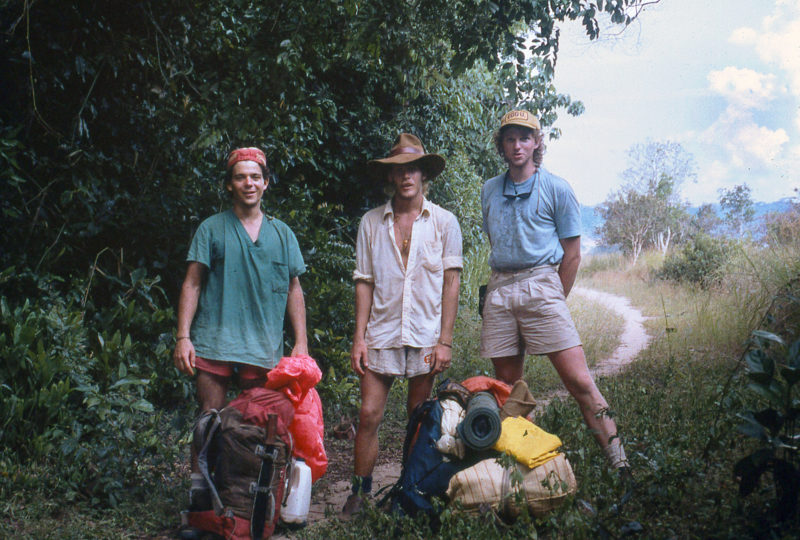 Tom DeVries
Tom DeVriesBrent Simpson, Ted Cooney, and Tom DeVries, (left to right) out in the noonday sun, were eager to find some shade on the two-day overland hike to Bongongo.
Heading out at 5 a.m. gave us a few hours’ refuge from the sun. We’d walked for an hour by flashlight, passing a village singing and drumming in mourning for a recent death, exchanging moyos—greetings—with hunters heading for the Bulape meat market with bloody monkey haunches, and passing a group of uniformed children making their way in the dawn light to the mission school. Two hours later, we climbed up into the bed of a big truck heading 45 miles along our way on the rutted, sandy road. At a fork in the road, we parted company, payed the driver, and continued by foot to the Lubudi River. There, a ferryman got us and our packs settled low in his pirogue and paddled us, herky-jerky, across the racing current. That wobbly ride left us a bit apprehensive about what lay ahead. Brent and I both groused to Ted, “Man, I hope our boat’s a hell of a lot more stable than that!”
Back on the trail, we trudged along, pack straps wearing grooves in our shoulders. The sun bore down relentlessly. That night, completely burned out, we threw down camp on the top of a sweeping savanna that commanded the green and brown hills of Kasai. By seven o’clock we were under mosquito nets on the hard ground listening to the bugs click and buzz and gazing at the dazzling diamonds in the African night sky. At 4 degrees south latitude, a 12-hour night follows a 12-hour day year-round, so we got a long night’s rest following our hard day laboring under the sun.
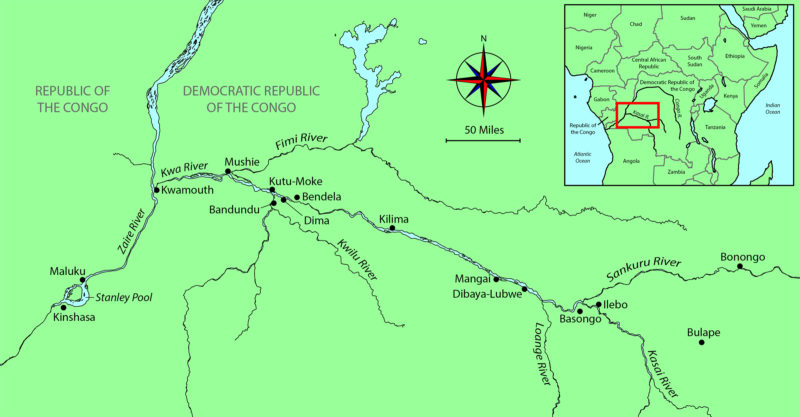 Roger Siebert
Roger Siebert.
The next morning, we followed the single-track trail off the grassy highland, across plains and through forest, occasionally passing a lone walker or a few grass huts. In one parched village there was a single tree centered in a bleak, boulevard-wide dirt plaza. Under the shade of the tree lay a bony, frothing dog. We beelined for the shade, dog be darned, and guzzled our water jugs. No one else stirred in this high-noon ghost town. Farther on there was cool water at a tree-lined stream swarming with thousands of blue and green butterflies. There were also nipping bees that found Brent and Ted, so we scrambled out of there. We guessed that the bees were attracted by the salt in the sweat on their shirts. The bees didn’t sting me. I hadn’t sweated all day. I was bone-dry dehydrated.
My mates were a bit concerned about me and tried refreshing me with mental popsicles by reciting, among other gems, “The Cremation of Sam McGee”:
There are strange things done in the midnight sun by the men who moil for gold;
The Arctic trails have their secret tales that would make your blood run cold.
I was more apt to conjure dismal images from Heart of Darkness, Joseph Conrad’s novel about a brutal voyage up the Congo River, than from Robert Service’s story of sourdoughs freezing on the Klondike, but it was good diversion just the same. My shirt was finally as soaked as theirs after a most welcome afternoon storm that drenched us sideways and pelted us with hail.
As we neared Bongongo, we started seeing more people on the path. Passersby greeted us with grins. It seemed to me they were whispering, “It’s them.” Someone passed around some palm wine. Someone else ran ahead to announce our arrival. We crossed a final bridge and entered the village as night fell. We had made it to the Sankuru! We were greeted as welcome guests. I drank water like a draft horse, met our hosts, and faded off to sleep.
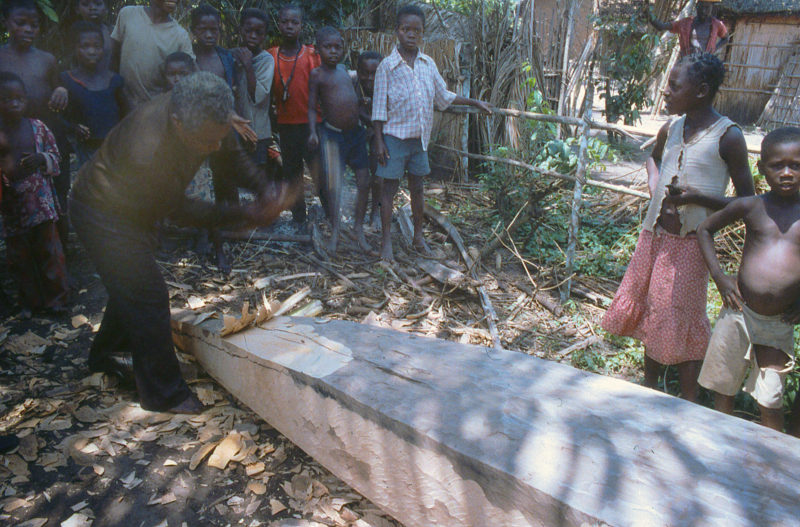 Tom DeVries
Tom DeVriesIt was wonderful to watch ALICE MAY get a final fairing. A few of the boys made a little money selling us their slingshots.
In the morning we got our first look at the pirogue Ted had commissioned. The barefoot, barrel-chested boatbuilder was still whacking out chips with his adze. The boat, a six-man canoe, measured some 33′ long, 3′ in the beam, and less than 20″ deep amidships. The sides at the sheer were 1” thick and thicker a bit closer to the bottom. There was no flare to the sides. The bow and stern each angled up from the flat bottom for 3′ or 4′ and tapered stylishly. Inside the hull were wedged three hardwood sticks used as thwarts. We christened the canoe ALICE MAY, after the derelict Yukon stern-wheeler used to thaw Sam McGee. Ted paid the builder with a shotgun forged near Bulape and shells for it.
We were eager to get on the water. Though we had little more of a plan than “let’s follow the rivers,” we had plenty of work to do before we launched. We bought three paddles and a bailer for the boat. The used wooden paddles, nearly 9’ long, were intended for paddling while standing. We were more familiar with Old Town canoes and thought we might be more successful paddling sitting down, so we bought stools. As word spread that the mundele—white guys—were shopping, young and old brought wares and it suddenly became market day. ALICE MAY was the main attraction, and we were the side-show curiosity. We made bargains for bags of rice, bananas, and hard candies; machetes, spears, arrows and slingshots; decorative fabrics, necklaces, and other local crafts. That evening there was palm wine and a pleasant feast.
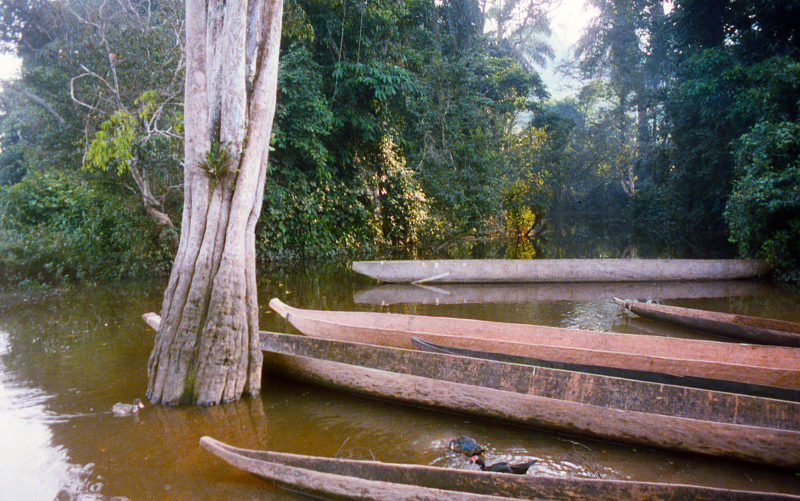 Tom DeVries
Tom DeVriesAmong older dugouts at this most pleasant cove in the jungle, ALICE MAY looks bright! We were more likely thinking about dinner food (maybe duck?) than the poetry of the place.
The whole village was out the next morning to drag, shove, and tug the new canoe to the river. The big dugout had dried some and a little water bubbled through some cracks as she was set afloat. Undaunted, our builder caulked them with burlap using a machete to drive it in tightly, and assured us everything would swell up soon enough. We had lashed together a cargo rack of bamboo and vine, and Ted had packed a tarp for rain cover. After we had loaded up, we bid farewell, and paddled off downriver—standing—a green pirogue carrying green piroguers. Around the first bend, and out of sight of the village, we sat down on our stools.
There was no guidebook for the Sankuru, Kasai, or Zaire rivers, and what information we had was just hearsay. No one we talked to knew of anyone who had made this trip by pirogue. Our Bongongo host, a retired riverboat pilot, guessed we’d be all right. We had a 1:3,000,000-scale map of Zaire which showed cities, towns, and larger villages, as well as missions along our route. We could make estimates of distance but at first had no good idea of how fast the muddy current carried us. We paddled mostly to keep in the main channel, and let the river do the work. While scouting for boats, Ted had been warned that he should watch out for crocodiles, hippos, and whirlpools. So we did.
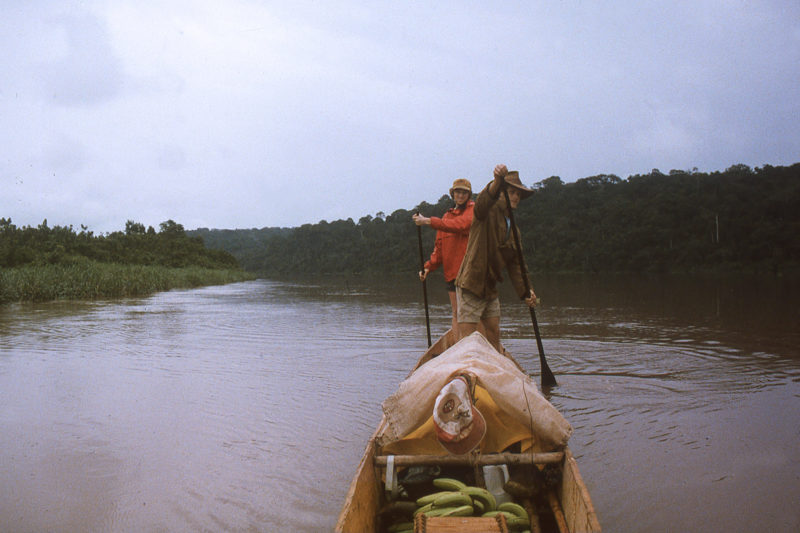 Brent Simpson
Brent Simpson Tom DeVries (left) and Ted Cooney enjoy paddling in the cool morning drizzle on the Sankuru River. ALICE MAY had plenty of room for the three us and our gear.
It sure felt good to be on the water. No more trudging under heavy packs. We sat, drifting. There were screeching monkeys and red-tailed parrots and fish eagles in the trees. Brilliant blue and orange kingfishers darted along tan sandy banks. The sun was blazing, so we often dipped into the river to cool off. ALICE MAY’s husky hull barely heeled when we climbed back aboard. We paddled standing. We paddled seated. We drifted. We were three boys on a lark—Huck Finns on a raft—adrift in the Congo Basin.
The wind picked up that afternoon and storm clouds threatened. Standing up, we paddled through the chop as rain started to fall, and with some effort reached a sand bar where three men had brought their pirogues ashore; two were butchering monkeys and one had a couple of fish. We brought a large catfish to cook for lunch and were invited to wait out the downpour in their riverside shelter. The boiled fish tasted like it had been slathered in butter and there was a lemon to drizzle on top—restaurant quality—but the monkey meat they were eating was unappealing. These Sankuru River natives had leathery faces, gnarled hands, and mashed feet with toenails missing. They were rugged, ragged, and gracious.
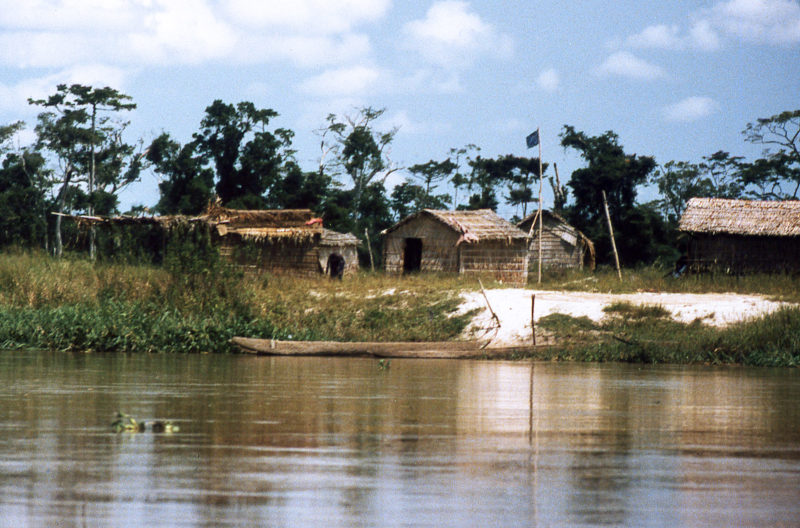 Tom DeVries
Tom DeVriesWe tried avoiding any place with an official look to it. A Zairean flag flies over this Sankuru River compound.
That evening we stayed in a village on the south side of the river. As was the custom, someone gave us the use of their dirt-floored, thatch-roofed, stick-and-mud hut. For dinner, a woman cooked the remaining catfish with rice for us and later we enjoyed a conversation with some of the local folks about the existence of God. French is the language of Zaire and Tshiluba the local tongue of the Kasai region. I understood a little in French and could greet passersby in Tshiluba. Of course, facial expressions mean a lot, but my participation in any meaningful local exchange relied on the well-versed Peace Corps fellows interpreting.
The mosquitoes that night were fierce. We had lit coils and hid in our nets, but the three of us only escaped the whining torment by wandering in circles outside until dawn.
For breakfast we kindled a small fire and boiled water for oatmeal and tea. The Quaker Instant oatmeal that I’d brought from the States wasn’t normal fare in Zaire and was a small pleasure from home for Ted and Brent. Bidia was the staple of the Zaïrois cuisine and we ate it often during our time in the country. It’s a manioc and cornmeal mush that resembles Play-Doh in texture and taste. Bidia is best served with matamba—greens—or a little chili pepper sauce, but sometimes we’d have it plain. We could often find citrus fruit as well as bananas for sale at villages along the river. We carried our large bag of rice and tins of pilchards and a few candies, although the M&Ms were long gone. Drinking water was plentiful; we always treated it with iodine.
We carried our paddles, stools, and bags down to the boat and got back on the water early. Feeling rushed, Brent quipped, “It’s not a race, it’s a river trip,” but I was driven to make progress. My visa was only valid for a month, and I didn’t want a hassle if I overstayed. We rotated paddling positions throughout the trip. This morning I was the stern man with Ted ahead of me and Brent in the bow. We paddled for a few hours and then sat for a break and drifted. We picked a village on the map for our next layover. The haze on the brown river gave everything the look of a sepia-toned photo. The rainforest dripped with heavy dew. Sometimes we heard talking or drums echoing. Paddling, we were mostly silent, lost in the wonder of the place. Fishermen and local travelers glided past in pirogues. They all asked where we were going and when we answered Kinshasa, they’d say “Ah, ah, ah!” with eyebrows raised in disbelief.
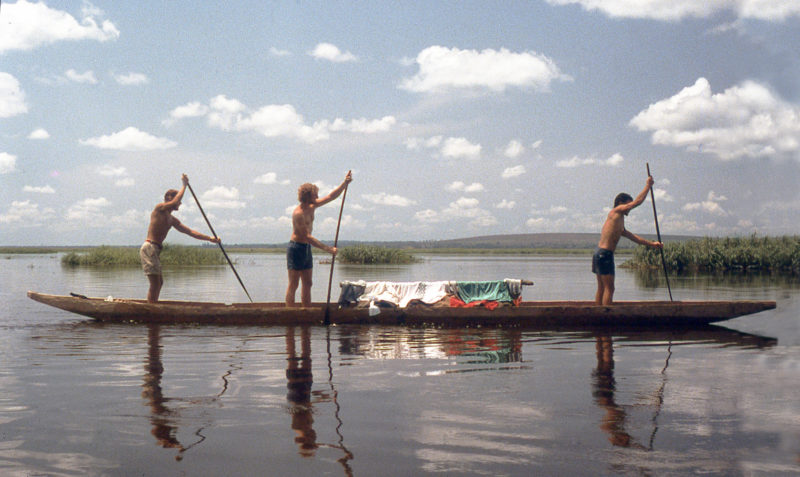 Keith Peterson
Keith PetersonALICE MAY was a “six-man” pirogue. We—(from left) Ted Cooney, Tom DeVries, and Brent Simpson—are putting our backs into it as the laundry dries. The hardwood paddles are flexible and strong.
Our third night on the Sankuru we stayed in the big village of Butala. We guessed we’d traveled 85 miles or so from Bongongo. ALICE MAY had tightened up and was no longer leaking, and the three of us felt like seasoned watermen. A barefoot crowd welcomed us to Butala and helped carry our gear up the muddy bank at water’s edge. Though we were strangers, we were treated as special guests. Butala was accessible by road but quite some distance from any pavement. Most huts were mud with thatched roofs, but the relative wealth of a few residents was evidenced by their metal roofs. At a roadside market stand we found some cigarettes, matches, canned tomato paste, chicken-fat soap, and local bread for sale. We bought a chicken for dinner to go along with some bidia and good palm wine. With machetes, we gathered some firewood, thinking the next night we could camp out on an island or find a fisherman’s hut on a sand bar. The map showed we’d be on the bigger, busier Kasai soon.
Sooner than expected, we reached the Sankuru’s confluence with the Kasai. There’d be no camp-out on the Sankuru. With two hours of daylight left we crossed, a hard 45-minute ferry against the merging currents. We paddled until shortly before sunset to make it to the town of Basongo on the southern shore of the Kasai. After a cooling bath in the river we secured our boat with cable and lock and hiked up the bank into town. On the trail we were met by Peace Corps crony Greg Mock, grinning ear to ear. He had been scanning the river, hoping to see three white guys paddling by.
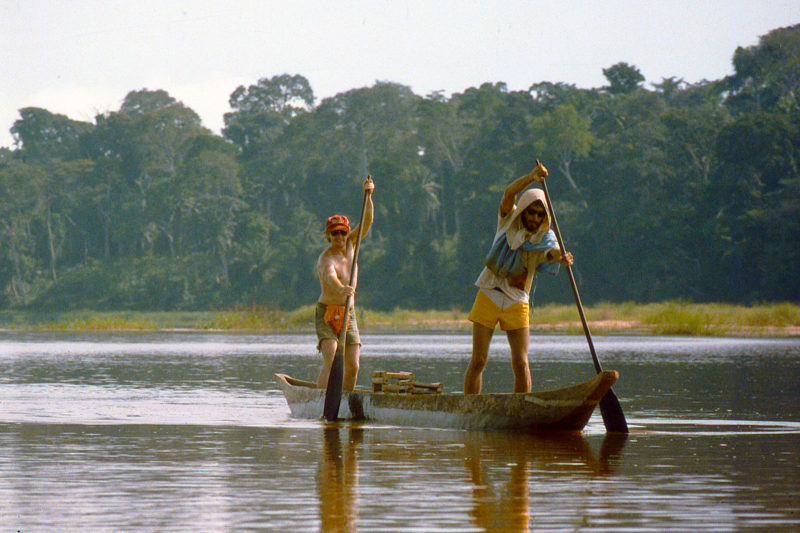 Tom DeVries
Tom DeVriesKeith Peterson (left) and Greg Mock worked their stroke on a calm Kasai afternoon. Their pirogue, FIFTY GOOD ONES, had wired and stapled tin strapping holding the bow together.
I had met Mock in Bulape where he was enjoying the company of a wayfaring Swiss gal while he was recovering from a bout of malaria. He had committed to Ted’s river adventure early on but wasn’t in shape to make the overland trek. Mock and our fifth compatriot, Keith Peterson, had traveled by train to the port city of Ilebo to find and join us on the Kasai River. Ilebo marks the end of navigable water on the Kasai and the terminus of a railroad that leads southeast to the mining city of Lubumbashi. Big river barges move fuel, equipment, goods, and people from Kinshasa to the railhead and return loaded with the production of the country’s mines, forests, and fields. After arriving in Ilebo, Keith had the equivalent of $250 stolen from his room while he was out having a beer, and in the dust-up that followed, passports were taken and threats were made by the local authorities. Mock made his way to Basongo, while Keith stayed behind, trying to get both the money and passports back.
In Basongo, green-uniformed gendarmes checked our papers. The Peace Corps boys had special passes permitting their passage down the Kasai and Congo. Their years in the country had taught them how to deal with Zairean officials, but bribery and theft were familiar here. My passport had a full-page visa stamped and signed at the consulate in New York, and Ted and crew kept me safely in their care. We were set up in what was once a fine colonial-era Belgian home, now empty, dingy, and derelict. The place was fair shelter, with a commanding view of the river, but we felt a bit unsettled under the watchful eye of the dictator Mobutu’s police.
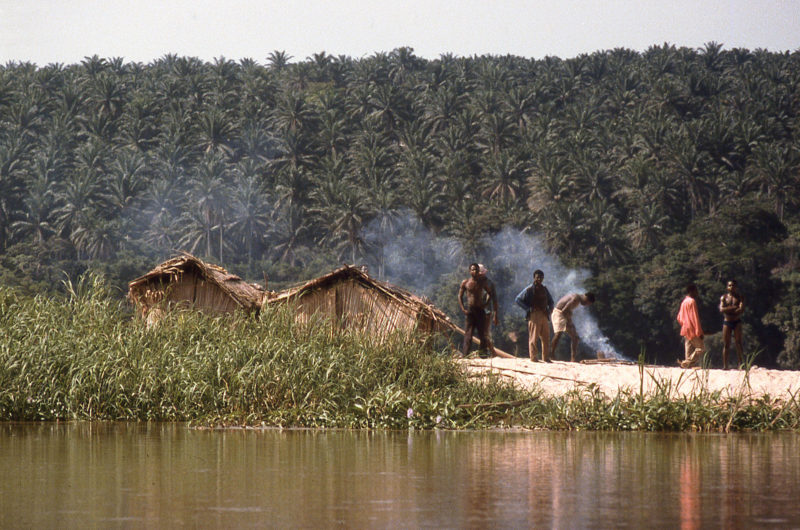 Tom DeVries
Tom DeVriesThese guys at a hunting and fishing camp on the Kasai River looked tough. None of them waved.
Two days passed before we got back on the Kasai. The first morning, Brent and Mock headed for Ilebo to reinforce Keith. Ted and I repaired and reorganized our gear, re-provisioned at ramshackle market stalls, and rested travel-weary muscles. Keith and his mates returned, having recovered only 2,000 Z ($50), about enough money to buy a second pirogue—three Americans and their kit seemed to crowd ALICE MAY. The second day in Basongo, while Keith and Ted were bargaining for a two-seater, the rest of us each enjoyed a dix-huit (French for 18)—a roasted guinea pig costing 18 Z—for lunch. For dinner, celebrating the new boat and new crew, we feasted on wild boar that we boiled and fried over an open fire. Fearing another hot, sticky night, we looked forward to an early start.
We were refueled and refreshed after the two-day layover. The five of us now floated on the waters of the Kasai River. Mock and Keith settled into our paddling and drifting routine. Their boat was christened FIFTY GOOD ONES, a tongue-in-cheek reference to a drill-sergeant of a supervisor the Peace Corps boys had all endured. It was shorter, narrower, and had less freeboard than the ALICE MAY. They paddled sitting on stools as we had first done on the Sankuru but were soon on their feet with their long paddles pulling. Keith was in his element on the water (he’d captained his university swim team) but Mock became somewhat withdrawn as the river widened and we ventured away from shore. We would drift apart or raft up as we explored or shared food and mapped out our overnight destinations. Everyone’s baggage was stowed onboard the bigger ALICE MAY.
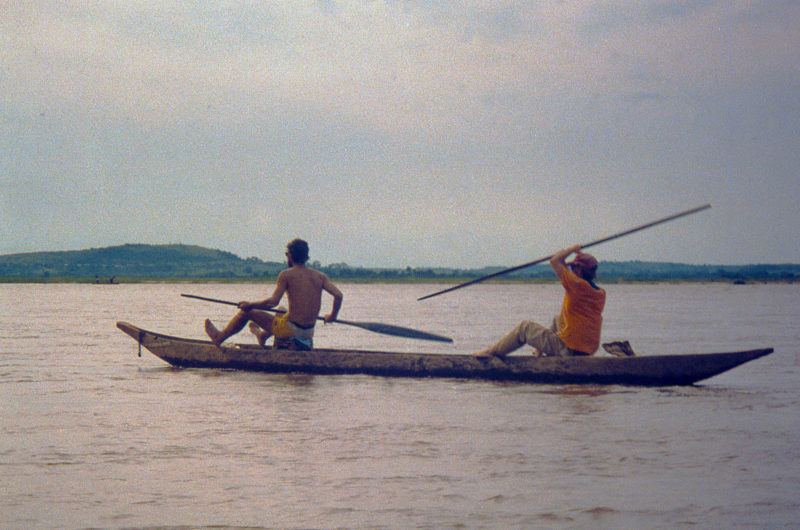 Tom DeVries
Tom DeVriesGreg Mock (left) and Keith Peterson often paddled FIFTY GOOD ONES canoe-style. Only in overloaded pirogues did we see Zaireans seated.
On setting out together that first morning there was smoke far off in the distance. Black belches clouded the sky. As we got nearer, we saw the hillsides all around were planted in neat rows of nut palm trees. We could smell the diesel smoke and hear the pounding and rumbling of the palm oil factory sprawling along the southern shore. A river barge as long as a train thundered along the far shore. Pirogues, large and small, plied the river. People were fishing, traveling, and ferrying goods. The mystery and tranquility of our magical days on the Sankuru had given way to a busy, boisterous, commercial waterway.
By midday we passed the Loange River, which formed the boundary between Kasai Occidental and Bandundu provinces. We were surprised at how fast we were traveling. Our navigation and dead-reckoning skills were not keeping pace with the flow of the river. Some passing piroguers said we could get to a mission in Dibaya-Lubwe by nightfall so, with the sun setting fast, we pushed ourselves hard.
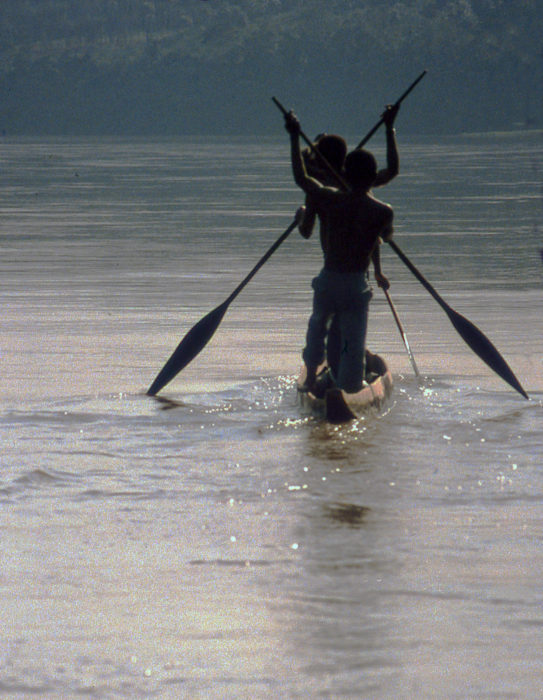 Tom DeVries
Tom DeVriesAs we were cruising across the Kasai River at dusk, these guys paddling made us think they were dancing on water.
We hadn’t had lunch, only oranges and a few hard candies, so the promise of a meal at the mission was good motivation. A fisherman hailed us in French as the sky darkened. He cheerfully guided us across the river under moonlight to the town’s landing. After unloading, we doused ourselves in mosquito repellent and, with many helpful local hands, carried our gear the mile from the river, through the village to the mission. We were welcomed by a kindly Belgian nun who passed around cold, fresh water, offered showers for all, and fed us well. Dinner was a light green soup, bread and margarine, fish, instant potatoes, and a fresh lettuce salad, and vanilla pudding for dessert. We left no crumbs. After a fine night’s sleep on mattresses with cool, white sheets, we were treated to a first-rate Belgian breakfast with European coffee. As we said our good byes, the sister snuck two tins of hot dogs in our bags.
For days, the weather had been calm, sunny and hot, with no rain. This morning big thunderheads brewed overhead. We got off the river at a plant that processed sisal for burlap near the town of Mangai. For 20 minutes we weathered the storm on shore, hosted by the Greek fellow in charge. Back on the river in the drizzle we noticed little whirlpools in the gurgling brown flow. Many locals we passed said we wouldn’t make it in our pirogues farther down the Kasai because of big waves ahead.
Dugouts and barges, large and small, negotiated the currents of the Kasai. It widened and formed channels around low islands and sand bars as it flowed toward the Zaire River (now called the Congo River) and the sea. One afternoon we were paddling toward a southerly runoff when two pirogues raced upriver to intercept us. The fishermen warned that there were hippos down that way. In the dry season the sand bars are where the hippos hang out, but at high water they move into the bush along the tributaries. We made our way upriver, not wanting a confrontation, though disappointed to miss a photo opportunity. Ferrying back across the river, here nearly 2 miles wide, we arrived at the village of Kilima.
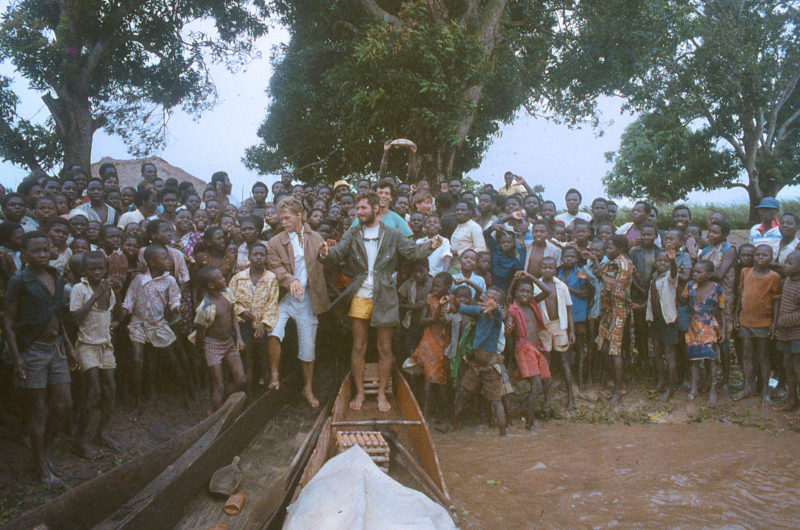 Tom DeVries
Tom DeVriesThis entire Kasai River village came out when we landed to wait out an afternoon blow. Here Ted Cooney, Greg Mock, Bent Simpson, and Keith Peterson (left to right) are surrounded by a sea of curiosity.
Our reward for another hard day’s paddle was an overnight at a riverside hotel consisting of a few bare rooms in a musty concrete block building. The sound of a running generator promised cold beer for our parched throats. After sundown we were roused by the rumbling of a mighty riverboat slowing its downriver run, making a 180-degree turn to point into the current and easing into shore, cabling off to a tree. In the jungle darkness, this ship looked to be more than 100′ long and 25′ or so wide. I climbed up to join Ted and Brent in the wheelhouse and learned from the bleary-eyed second captain that his tanker was one of three running diesel fuel from Kinshasa to Ilebo for the copper mines at the end of the rail line. This trip took five days upriver, full, and three days back, empty. He and his crew were stopping for much-needed sleep.
We reviewed the kind captain’s charts and recorded distances. Nine miles from the confluence of the Kasai and the Zaire was a perpetual 35′ whirlpool on the southern bank. It was something to avoid, so we would pull out into the middle of the river when we reached the Zaire. Now we had a check on our progress and a fair idea of what lay ahead. We had been on the Kasai for three days and were averaging close to 60 miles per day. With fair weather and steady progress, we could make the 317 miles to Kinshasa in a week.
Fair weather was not to be. Heavy rains kept us in Kilima until late morning. We left in a spattering breeze with hopes of gaining 31 miles and making another mission by nightfall. Ted was stern man in ALICE MAY this day; Keith and Mock in FIFTY GOOD ONES followed us. Cross-winds increased and made steering difficult. We tried the lee of an island but grounded on sand bars. A half hour of hand-hauling the heavy boats got us afloat. Later, Keith drove FIFTY GOOD ONES back down a channel toward the north shore, waves piling on. We followed. Bailers got steady use. Looking ahead, we saw a curious crowd of hundreds running alongshore, watching as we made landfall in the gale. Everyone on shore was giddy. Some of the kids had never seen mundele before! A few tried wiping the white off my face with nervous fingers. We were white dots in a sea of brown. After staying an hour in what we called the “Hurricane Village,” sharing the excitement, we decided to push back out into the obstinate wind. The rest of the day we paddled from our stools, hunched low in the blow, grinding on until we made the mission.
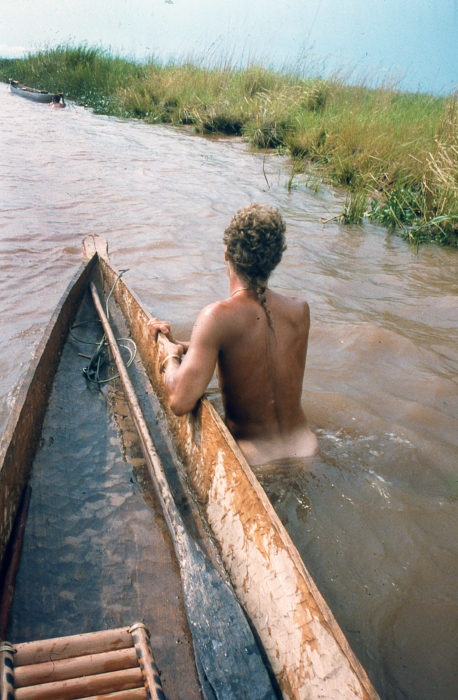 Brent Simpson
Brent SimpsonA heavy head wind blew and the heat was wearing us down so we hand-hauled the boats. Here, Ted Cooney is happy we didn’t surprise any crocodiles.
The following afternoon we pulled toward a village, hoping to find provisions. Another crowd gathered, but the villagers here were agitated and loud so we backed away. Some local official yelled at us to come back. Brent kept asking “Why?” but got no answer. We carried on downriver. Looking astern, we saw ten men in a big pirogue coming after us. We kept up a slow, steady stroke, keeping our boats close. The chasers eventually overtook us and demanded identification. There were billy clubs and metal rods in the bottom of their boat. After examining our passes (a few of the fellows “reading” paperwork upside down), they permanently “borrowed” our bailer, wished us well, and put their backs into a very long return home, upriver.
For days the surrounding countryside had been sprawling lowland, tree-spotted savanna. Now forested hills were prominent. The Kasai choked down and we were in the Narrows. Channel markers bobbed in the quickening, turbid current and the wind left us alone. Without a breeze, the African sun scorched us, but the paddling was pleasant and we made good time.
On the 13th day since launching ALICE MAY, we stopped midday at the mission in Bendela. We washed clothes in the river. Ted and Keith bought 20 loaves of bread and we enjoyed our last tin of hot dogs in bread-slice buns for lunch. In the afternoon we steered wide of what looked like an abandoned army post in Dima, on the river’s south bank. Past that village, the Kwilu River added its brown water to the Kasai and the valley opened up again. We ended the day’s paddle in Kutu-Moke on the north bank and were once again welcomed by strangers as long-lost friends. Here we were housed in a swampy concrete office building erected in the 1950s during the heyday of Belgian colonial rule. Villagers brought us a basin full of manioc, bananas, tins of sardines, and matches. Some came by to socialize. The village chief shared his knowledge of the river, including what he knew of the whirlpool on the Zaire.
After dinner, while Ted, Brent, Keith, and I played cards, Mock lay low, lost in a book. My innards were unsettled but my card mates were able to enjoy some beer. There was a tap at the door. Keith answered and said there were well-armed military guys outside. An officer looked over our papers and said he wanted us to go to Bandundu to see the colonel. After ten minutes of futile argument, Ted said he’d go. Brent and Keith agreed to go too; Mock wanted nothing to do with the authorities and he stayed with me under house arrest. Our Three Musketeers dressed in their finest clothes that night and Ted and Brent strapped on their Bowie knives, while Keith left his Mom’s phone number in my notebook in case he was detained (he hadn’t yet recovered his passport, lost in Ilebo). Out into the night they went—“up the river.” Finding it hard to sleep, Mock and I listened to what was happening in the rest of the world on his shortwave radio. Later I finished reading The River Congo, by Peter Forbath, which gave me a better understanding of the country I was in. We both hoped for the best.
The next morning, the two of us shared the last of my oatmeal for breakfast. Roosters crowed. The soldiers who had been guarding us were nowhere around when I found my way to an outhouse. Our three bedraggled boys returned around 9 a.m. Nothing came of their all-night shakedown. They never saw the “colonel” and were worn out by the bogus runaround. A benevolent river man had bought them bread and coffee and run them back down river in his 25-hp pirogue. We accepted a tow downriver a ways from Kutu-Moke, for we wanted to get to the mission in Mushie that night. Corruption and kindheartedness were both ingrained in Zairean society. A night at a mission offered respite.
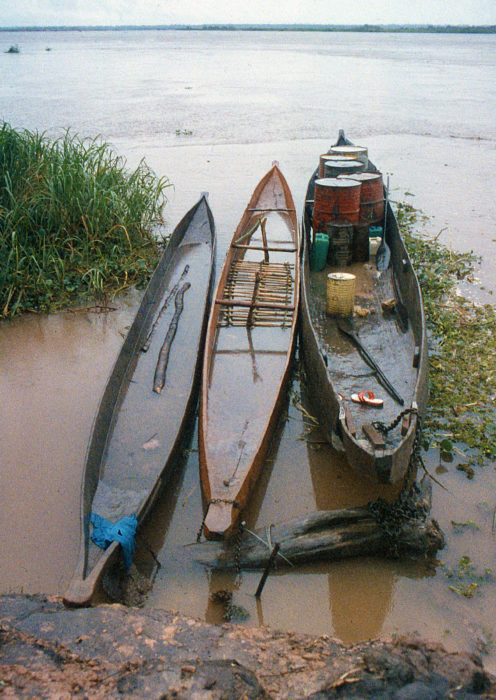 Tom DeVries
Tom DeVriesAny port in a storm. FIFTY GOOD ONES and ALICE MAY chained and cabled to a driftwood mooring alongside a bulky freight pirogue on the Kasai River. We had a lot of bailing to do.
Getting to Mushie was a push. Our fisherman friend had given us landmarks. This stretch of the Kasai was unsettled country, and he instructed us to look out for three prominent points of land and then a village on the left bank, after which we should be in sight of the mission town across the river. We paddled in the main channel until a fresh wind whipped up with angry, gray sky all around and frothing brown water splashing over the bow. In the ALICE MAY, we did the tarp drill, covering our gear, and snuck in toward a near-shore island. FIFTY GOOD ONES followed. Several 2′ swells rolled over the sides of the big pirogue as we paddled. We pulled into a cove and shared some bread. With three hours of daylight left we decided we could push and pull our craft, walking through the shallows, hand hauling to make some headway. Black clouds rushed overhead and lightning flashed to the north. Rain fell ahead of us and to the south. We crept along the island. The wind let up, the sky cleared, and the rains passed us by. Night fell as we paddled into the mission town.
Everyone was drained. The Musketeers had had no sleep the previous night. The rough water and waves were disquieting to Mock and he was on edge, knowing that only bigger water lay ahead. My bowels were rebelling, and even though I could purge at will while in the water, the bloat left me feeling feeble.
Our spirits were raised once more by the goodness of a stranger. The kind père of the mission in Mushie fed us soup and bread. There was summer sausage with mustard and mayonnaise. He served cold water, peanuts, pastrami, and more bread with butter. Real butter! This man could speak fair English, so even I could enjoy some table conversation. We talked for hours, in spite of our weariness. For dessert there was a beautiful, ripe papaya. The priest’s advice to chew up some papaya seeds helped calm my rumbling gut. He told us there were very few people living along the river where we had recently passed because of the prevalence of the tsetse fly. He called the area “The Sleeping Sickness Capital of the World.”
At Mushie, the tan waters of the Kasai are joined by the black waters of the Fimi River. From Mushie to the Zaire River the waterway is known as the Kwa. Entry to the Zaire River, the Congo, was only a day away. I had read in Peter Forbath’s book that following Portuguese making landfall in the 1400s, the names Congo and Zaire have been used interchangeably to describe the world’s second largest river. The indigenous people of the great river basin were part of the powerful Kingdom of the Kongo. The name Zaire comes from a Portuguese translation of a Kongolese word meaning “the river that swallows all rivers.” In 1971, the land known as the Belgian Congo officially became Zaire, as the newly independent African nation tried to move on from its brutal colonial past. A hot day of paddling on the Kwa, with very little wind, got us to the lumbering port of Makayuba.
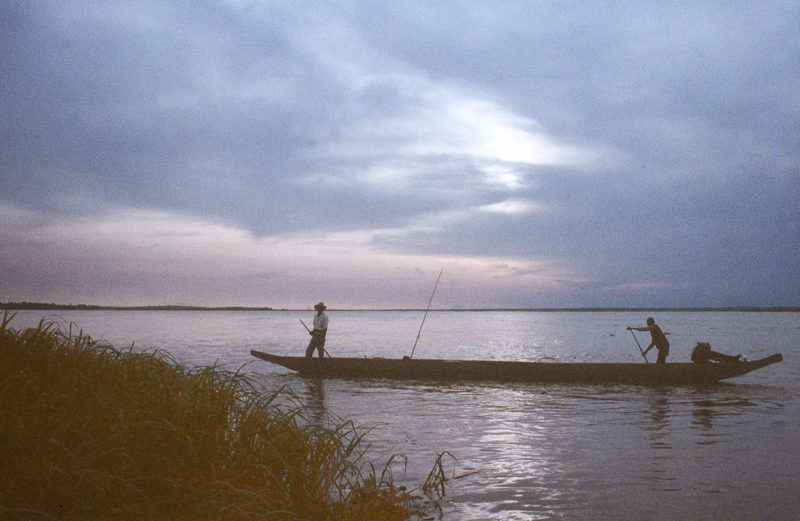 Tom DeVries
Tom DeVriesThis was, by far, the biggest dugout we saw on the Sankuru, Kasai, and Congo Rivers.
Up early next morning, we paddled the 9 miles to Kwamouth where we checked in before embarking on the Zaire. It was another hazy, hot morning. The busy port of Kwamouth was bustling with people and pigs boarding the wooden banana barges that moved much of the river’s local commerce. We were told by port officials that we didn’t need guides for the Zaire, “Just pull out into the current and stay toward the middle because of the whirlpools along the bank for about 2 miles or so.” We remembered the tanker captain in Kilima had said to look out for whirlpools 9 miles after the confluence.
After finalizing paperwork and eating a bit, we headed out. The powerful current was palpable and for an hour we zipped along. On our right, on the western shore of the mile-wide Zaire River, was the People’s Republic of the Congo (which existed from 1969 to 1991). As a communist nation, it was not known as a friendly place for Americans. That foreign shore was defined by stony bluffs. Looking back, upriver, we noticed a dark sky threatening rain. We stayed in the middle to avoid whirling waters but started to draw to the left. A roar like a freight train grimly rumbled. “Looks like we’re in deep shit,” Ted mumbled. We doggedly paddled for the far Zairean shore. We hollered at Keith and Mock to do the same. “Holy crap!” they cried.
A fierce wind whipped up the river and rocked us. Rain blasted. Brent struggled steering the ALICE MAY. Keith and Mock fell behind. Brent yelled, “They swamped!” I looked around and they were gone. We were struggling, too. I was pulling furiously in the bow. Ted was frantically bailing. We kneeled, knees wedged against the hull like we were running haystacks in a Class-IV rapid. Brent urged, “Come on boys!” straining to hold us into the wind. We labored. Muscles drained, we eventually gained the sandy shore and poled to a small landing. A crowd of tough Zairean fishermen had gathered. They applauded our efforts, shook our hands. But no one had seen FIFTY GOOD ONES.
Winded and worried, we searched the main current and the far shore through a camera with a telephoto lens. The three of us were racked with anxiety for our mates. The wind abated and the river flattened some. We didn’t spot anybody or anything floating. About a third of a mile downriver we saw a small, steel-hulled riverboat, hove-to in the current. Had it passed us in the storm?
The wind diminished. We headed back onto the river to find out what the boat’s captain had seen. As we took off, the riverboat sounded its horn and moved out into the mainstream too. Closing together, we made out a white man in the wheelhouse. It was Mock! Then we saw Keith on deck, smiling and waving. FIFTY GOOD ONES was in tow.
It was a relief to reunite onboard the riverboat. Mock was tight-lipped but Keith was animated, describing how the waves filled the boat, and with only two aboard bailing proved impossible, and they foundered. They held on and floated about half an hour in the turbulent river. Keith stuck his white T-shirt on the tip of his paddle to flag the riverboat as it passed.
Mock’s days in a pirogue were done. He had fulfilled his promise to accompany Ted. His friendship was sincere, but this upset on the Congo River was enough. He remained in the safety of the wheelhouse while we all caught our breath. Keith was game to carry on. After 20 minutes in tow, four of us climbed into ALICE MAY, handed up Mock’s duffel, and were floating the mighty Congo once more.
Keith, Brent, Ted and I enjoyed each other’s company, and the six-man canoe was a fine vessel for four. Our daily rhythm on the Congo River proved similar to our routine on the Kasai. We got on the water early, we paddled, and we drifted. We ate fish and rice, bidia and chicken, papaya and bananas. We passed riverboats and barges, all manner of pirogues, riverside villages of mud and thatch, river cops, and military outposts. We weathered wind and rain and blisteringly hot sun. We played cards at night and got going at first light. We kept a closer weather eye now and stayed close to the western shore. We respected the power of the “river that swallows all rivers.”
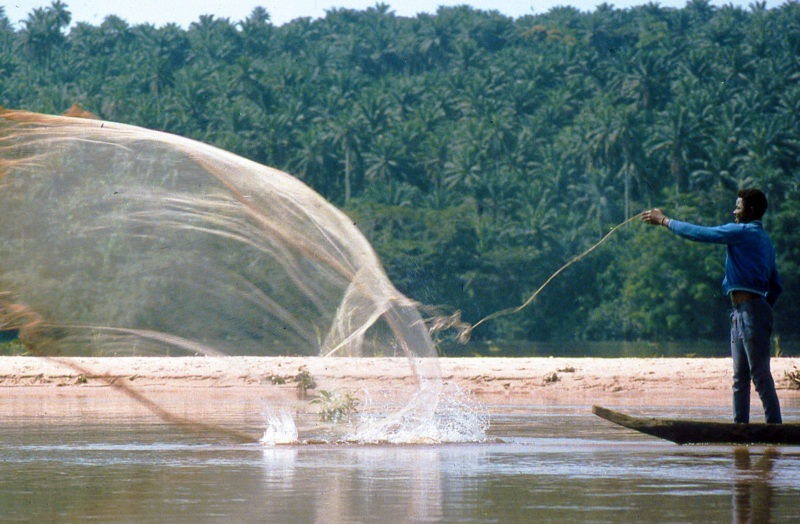 Tom DeVries
Tom DeVriesWe watched this fellow fishing for ten minutes as we drifted past the plantation palms. His cast-net technique was well practiced but we didn’t see him land any fish.
We saw Mock unexpectedly two days later. We had only been paddling a few hours on what turned out to be our last day on the river when a motorized pirogue came alongside. We were told that we needed to check in at the military post in Maluku upriver. So back we went with ALICE MAY in tow behind the pirogue. Mock met us on shore, once again grinning ear to ear. It was evident that with solid ground underfoot he had regained his good humor. His riverboat ride had gotten him to this town, and here he had sold FIFTY GOOD ONES. He was still waiting for final approval of the sale before he could go to Kinshasa. After a quick visit, the army commissioner amicably approved our papers and we shoved off from shore one last time. Stanley Pool, where the river widens to 15 miles and wraps around dozens of islands, gaped ahead with the Crystal Mountains looming beyond. We finished our journey in the company of clumps of flowering water hyacinth—flotsam flushed from some unknown river, hundreds of miles away, swallowed by the Congo.
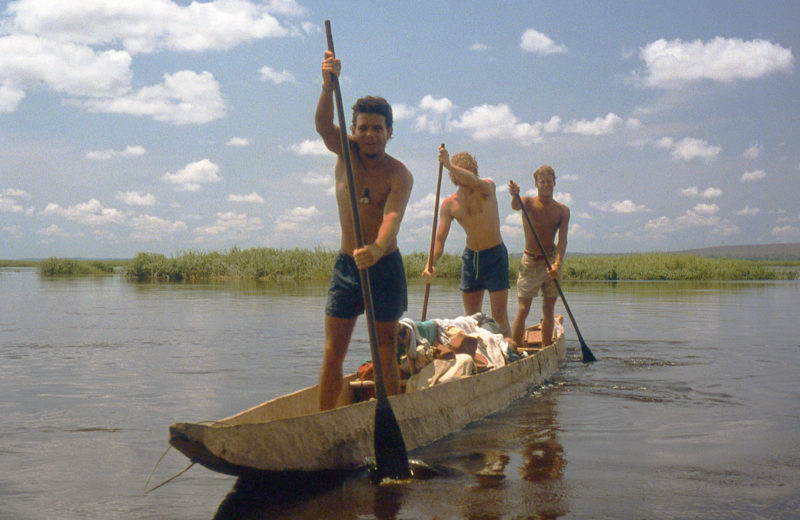 Keith Peterson
Keith PetersonWe relished the fantastic weather among the sand bars and islands of the Kasai River. By this time we had found our paddling rhythm. From left: Brent Simpson, Tom DeVries, and Ted Cooney.
For a few days, the five of us got together in Kinshasa and enjoyed the good food and cold drinks the city had to offer. Brent left for unfinished business at his post in the city of Mbudji Mayi. Keith helped me get my visa sorted out. His next stop was an Indian Ocean beach in Mombasa, Kenya. The last time I saw Ted in Africa, he was getting on a ferry to cross over Stanley Pool, making his way to Mount Kilimanjaro. His African adventures weren’t over yet. Mock stayed with me then and helped me get to the airport in Kinshasa that night as I headed back to New York. With my luggage were three 9′ paddles carefully wrapped in a rain tarp.![]()
Tom DeVries and his wife Tina live in New Braintree, Massachusetts. Now that both of their kids are off to college, he spends more time in Beyond Yukon Boat and Oar, his woodworking shop, and imagines that with the kids away he and Tina will be spending more time together fishing, paddling, and sailing in little boats. In years gone by, Tom has also canoed on the Yukon, fished commercially in Alaska, and sailed his skipjack on the Chesapeake. He wrote about DIY riveting hammers in SBM, December 2018.
If you have an interesting story to tell about your adventures with a small boat, please email us a brief outline and a few photos.

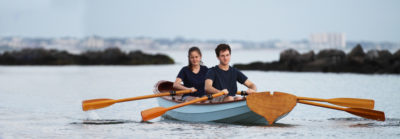


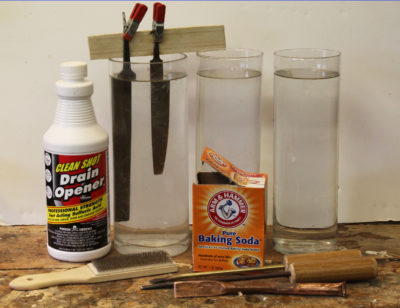
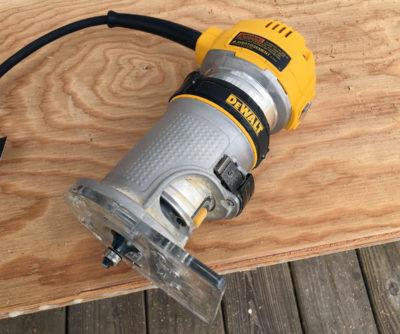
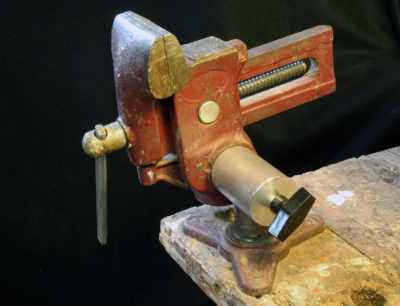
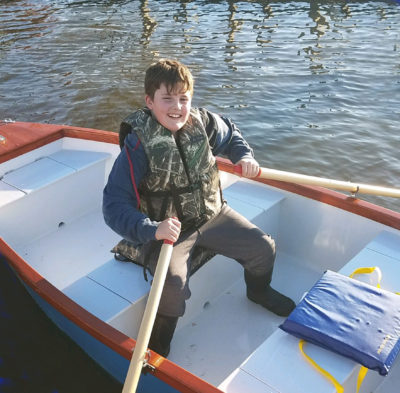
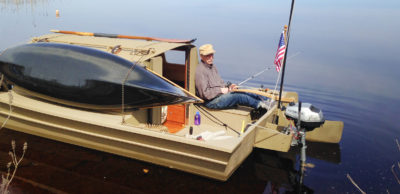
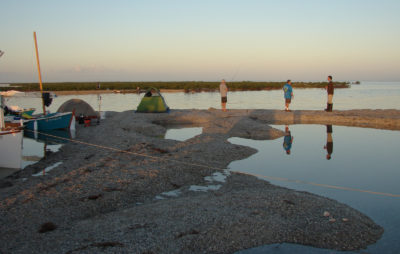
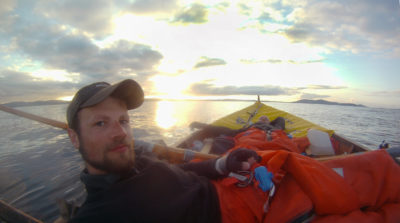

What a great yarn! I recommend as additional reading Mary Kingsley’s Travels in West Africa, written in the late 1890s. She taught herself to paddle a one-person dugout, explored a large area marked as “unknown” on the maps, and thrived on the heat. In fact, she hated the English climate when she had to return. She invariably wore Victorian-era gowns, even in the bush, and identified many new species of fresh water fish. She climbed Mt. Cameroon virtually solo (her porters/guides gave up well before the top), and would enter a strange village with the announcement that “it’s only me.” She was a delightful writer, with a wry, ironic sense of humor. She was a pioneering ethnographer, back in the days when that didn’t exist as a profession.Her brother, Charles Kingsley, was a well known novelist.
If you can find it, I recommend the unabridged version. The condensed version leaves out a lot of very interesting material.
The abridged version of Travels in West Africa is in the public domain and available at Project Gutenberg.
Ed.
David,
It’s great getting to the end of a chapter and finding something new on the “for further reading” list. I have not read Mary Kingsley and will eagerly seek out her books. Thanks for the recommendation. Forbath’s Congo and Alan Moorehead’s White Nile and Blue Nile formed the basis of my understanding of European exploration in central Africa.
What an exciting adventure. It was good to read about the kindness of the villagers – similar to our experiences kayaking the Mississippi. River people are the best. I also loved the African cultural flavor of your adventure! It was great to read about your journey!
Thanks Barb,
It’s good to have friends in far-flung lands and to get the opportunity to explore places and meet people you might otherwise only read about.
Hola Thomas,
I just got this article from a fellow Peace Corps volunteer yesterday. I was just reading the comments from this article. I also climbed Mt. Cameroon shortly after we did the river trip . I froze my pelotas off because I only was wearing a T-shirt and a pair of Zairian work boots. The road is long brother. Somewhere along the line I got a real job working rotating shifts. The river trip got me through many jet-lagged years working the graveyard shift. The river did not break me, the mountains did not either. I must say working rotating shifts did. I could not sleep too well for many years. I am working on a book about my sleep deprived years. You will be the first person I send a copy to when it gets printed. Mr.Ted recommended that I hitch a ride with a bunch of Zairian academics in land rovers going from Kinshassa to Lubumbashi, when I was on vacation the second year in Zaire. I got some tales to tell about that. And The guy who sent me your article tried to jump ship from the Peace Corps to a tannery that a Dutch volunteer started in Kananga because there was no leather then. He was a physical therapist and he needed the leather for braces for the handicapped there. He was so good at it, big game hunters were bringing their pelts to him for tanning. It became an incredibly successful enterprise. I think that I am going to get a subscription to Small Boat Magazine. I took a sailing class during COVID at lake Erie. I am still trying to overcome my fear of water and everything else. Good job on the article, broheme. Tell Ted I said bishi.
LOVED reading this!! I was a Zaire Peace Corps volunteer from 1985-87 – living in Lisala on the Zaire river my first year, then Kikwit my second year. I recommend the film “Downstream to Kinshasa” made by a Congolese director in 2020. . My trips on the river were how I got to post, either coming down from Kisangani, or up from Kinshasa – on the big white ferry. Live in Cambridge now, in case you ever want to paddle on the Charles, let me know!